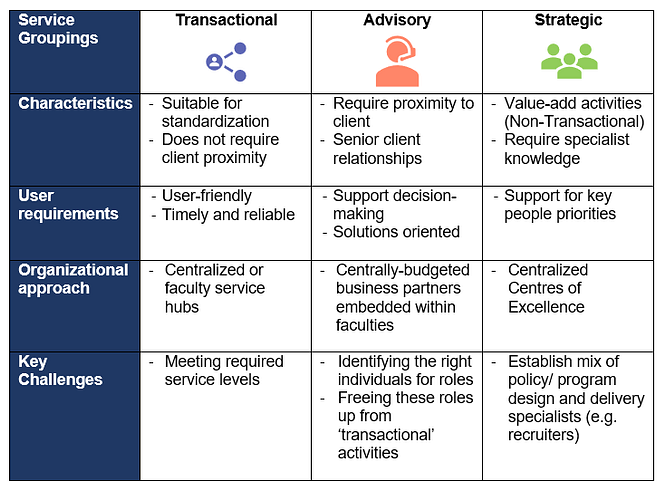UniForum data shows us that HR service delivery models can vary widely across institutions. In fact, the percentage of HR resources managed by central HR teams vs. in a distributed manner across the university ranges from 25% – 95% within the UniForum group. The variability is driven by the fact that regardless of the formal structure there are often ‘shadow’ processes being used across faculties and departments with highly localized support. UniForum data helps to make these ‘unofficial’ structures transparent to leadership teams.
This variability is often an opportunity for HR to be one of the first areas to tackle when looking to improve ‘corporate’ administrative services. HR is an area impacting a broad range of stakeholders, and there is often a strong business case to improve both efficiency and service effectiveness.
Amongst the UniForum member institutions that have embarked upon HR transformations, we have seen a few core steps that are imperative in leading an HR transformation across the university. These steps do not necessarily need to occur in quick succession and may often involve multiple phases to reach a more stable end-state.
1. Service Delivery Model and Benchmarking
The first stage requires an understanding of the current state of HR services at the university. A common first step is to create a comprehensive HR service catalogue to understand the full suite of HR services provided throughout the university and the hand-off points amongst the HR staff, intermediaries and customers – these include end to end HR activities that service the whole institution:
- Attract, recruit and on-board staff and faculty
- Development and support of talent
- Retention and growth
- Compensation and recognition
- Staff and Faculty relations
- Workforce information and data
The catalogue can then be used to understand the level of involvement required across the university for delivering HR services. A more comprehensive view, such as that from the UniForum data collection, can provide a picture of where HR services are currently delivered within the university as well as the overall efficiency of the process using benchmarking or other sector comparisons. This should be used in combination with an understanding of service user satisfaction, such as the UniForum Service Effectiveness survey which measures staff (academic and non-academic) satisfaction within administrative services, to help delineate where different service work most effectively.
2. Process and organization design
Based on the established strategy and knowledge of services, the next step is to define the new operating model, with careful consideration around reporting lines (e.g. organizational vs functional). This provides a clearer view to the HR leader of all associated HR activity within the university and enables a more robust on-going view of HR resourcing. Using the HR services catalogue a clear allocation of responsibilities can be allocated across the structure. Amongst UniForum members that have transformed their HR service model, there are three common categories of work that are assessed for redesign:

3. Change Management, Implement and Reinforce
The next crucial step is to provide support to staff transitioning to new service model and to be sure to listen to customers and departments/schools) to refine the model as required to meet any gaps. Regular measurement of staff satisfaction as well as resourcing requirements for service delivery can be used to help track changes to the both satisfaction levels and resourcing requirements, comparisons to the sector are enabled by the UniForum collections.
Where HR staff are co-located with their clients (embedded), leveraging communities of practice can support further development and innovation through sharing of best practices as well as testing improvement opportunities.
4. Key Lessons Learned
Across the UniForum universities that have embarked upon transforming their HR services, there are several key lessons learned.
Platform for and Starting Change
- Implementation of new HR systems can be a compelling platform for change and provide the groundwork for evaluating the end-to-end processes
- Pilot approaches can be low-risk ways to prove capability and benefits (e.g. pilot business partner in one faculty first)
- Find the right balance between getting broad engagement across the university without leading to paralysis to act
Organization and Operating Principles
- Identify the services that are best suited to self-service rather than requiring interaction with Tier 1 service support
- Need clear and firm operating philosophy, particularly for which activities need to be picked up by hiring managers (e.g. fixed term renewals)
- Delicate balance between having a sufficient local presence to support the local senior team needs while avoiding over-resourcing – what is the right ratio of business partner roles to staff supported? This can be impacted by the expertise of those in the business partner roles.
- How do the approaches applied to HR fit with the wider set of administrative offerings at the university? For example, for the service hub would a multi-functional be more effective and efficient than a functionally-focused one?
Creating a high performing HR service at a university can be a complex process that will take broad levels of engagement across the institution and thoughtful design on what works best for each specific community. However, keeping the key principles discussed here are helpful starting points to building a more efficient and effective service. If you are interested in learning more about how UniForum can help you better understand how your current HR services are delivered and ways it can enable measuring change over time, please contact us.
This article was written jointly by Steven Chan, Consulting Services Manager in the Canada team, along with Haseeb Kamal, Managing Director for Canada.
